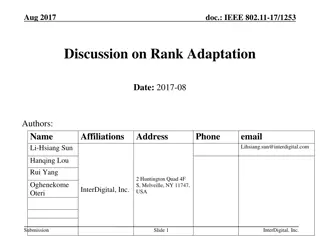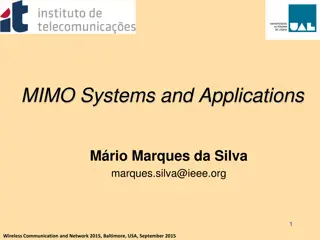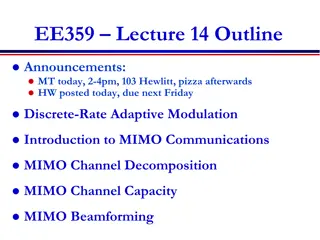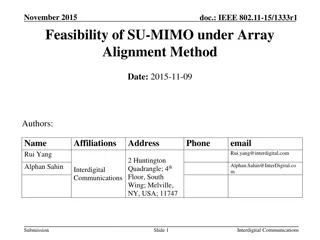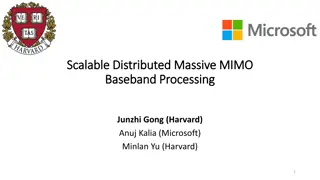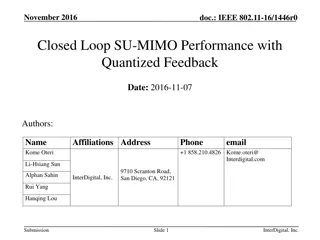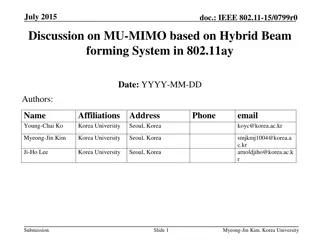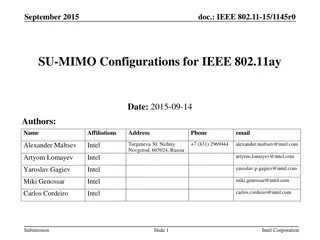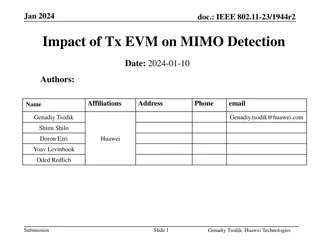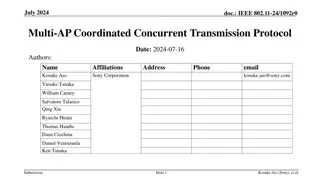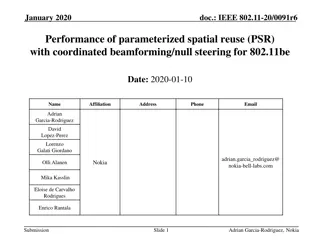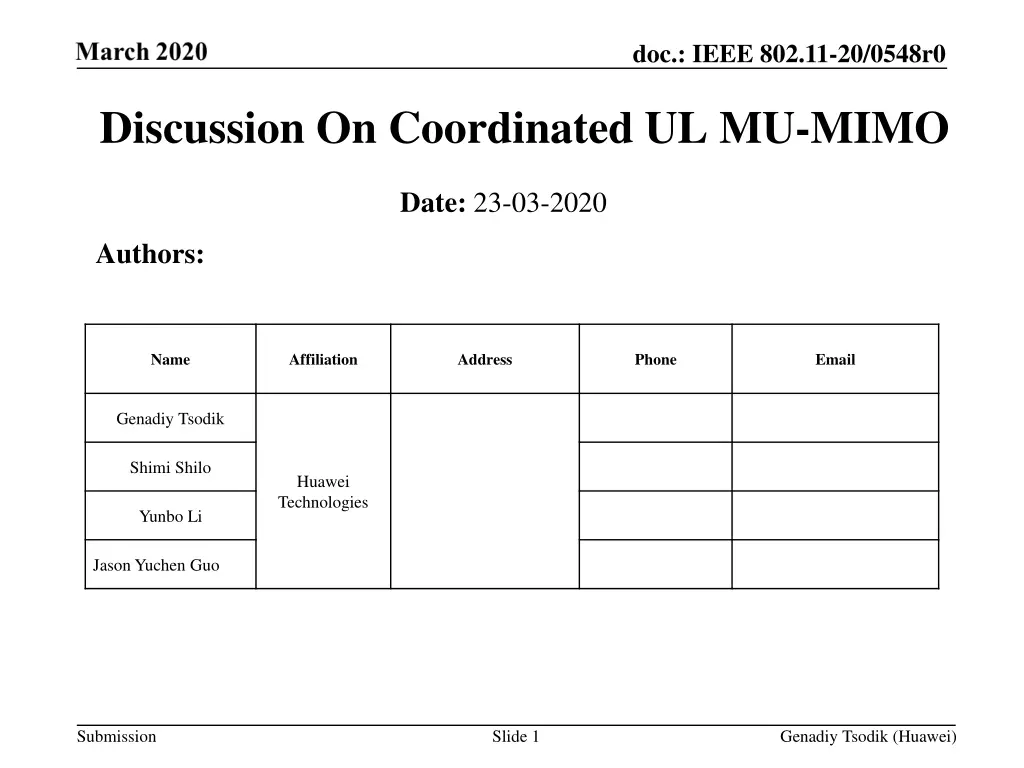
IEEE 802.11-20/0548r0 Coordinated UL MU-MIMO Discussion
Explore the benefits of Coordinated UL MU-MIMO transmission in IEEE 802.11-20/0548r0, analyzing various cooperation schemes and their advantages in different scenarios. Focus on proposed schemes for UL Coordination and the performance comparison of interference mitigation methods.
Download Presentation

Please find below an Image/Link to download the presentation.
The content on the website is provided AS IS for your information and personal use only. It may not be sold, licensed, or shared on other websites without obtaining consent from the author. If you encounter any issues during the download, it is possible that the publisher has removed the file from their server.
You are allowed to download the files provided on this website for personal or commercial use, subject to the condition that they are used lawfully. All files are the property of their respective owners.
The content on the website is provided AS IS for your information and personal use only. It may not be sold, licensed, or shared on other websites without obtaining consent from the author.
E N D
Presentation Transcript
doc.: IEEE 802.11-20/0548r0 Discussion On Coordinated UL MU-MIMO Date: 23-03-2020 Authors: Name Affiliation Address Phone Email Genadiy Tsodik Shimi Shilo Huawei Technologies Yunbo Li Jason Yuchen Guo Submission Slide 1 Genadiy Tsodik (Huawei)
doc.: IEEE 802.11-20/0548r0 Introduction Various cooperation schemes are discussed as candidates for DL and UL coordinated transmissions All the proposed schemes have advantages in certain scenarios, whereas in other scenarios - other schemes may be preferable In [1] we introduced a Coordinated UL MU-MIMO transmission scheme and studied its properties and performance In this contribution we want to review the scenarios where the proposed scheme has advantages and suggest it as a candidate scheme for UL Coordination Submission Slide 2 Genadiy Tsodik (Huawei)
doc.: IEEE 802.11-20/0548r0 Short Recap The main idea [1] is to allow parallel UL transmissions of multiple BSSs by extending UL MU-MIMO defined in 11ax (not possible today with existing Trigger Frame type and formats) Orthogonal LTF signals allow each AP to estimate channel of each STA independently and apply MIMO detection or interference mitigation The suggested scheme doesn t require phase synchronization, but requires a solution for triggering multiple STAs from different OBSS We compared the performance of different interference mitigation schemes and showed an advantage of the proposed method Master AP UL Coordination Negotiation Procedure Coordinated UL Trigger Slave AP Full Alignment Data Frame MU-MIMO HE-LTF STA1 Data Frame MU-MIMO HE-LTF STA2 Time Submission Slide 3 Genadiy Tsodik (Huawei)
doc.: IEEE 802.11-20/0548r0 Discussed Coordination Schemes Currently four main schemes were proposed for AP Coordination: Co-OFDMA, Co-SR, JT and CBF, where two last schemes are proposed for DL coordination Co-SR and Co-OFDMA require minimal synchronization (or none) and allow multiple transmissions (DL and/or UL) during the coordination period We want to focus on cases where the AP needs to trigger an UL transmission (with no preceding DL data packet) Co-OFDMA requires negotiation and agreement between APs preceding the coordinated transmission In case of Co-OFDMA the throughput will be reduced to 1/N per OBSS where N is the number of OBSSs participating in Co-OFDMA (assuming symmetric BF division) Co-SR introduces a trade-off between robustness and efficiency, and requires additional overhead in more complex schemes (like OBSS RSSI indication for PSR or channel sounding for PSR with Null Steering) So we would like to have an additional solution that allows less throughput reduction and requires less (or similar) overhead for triggered UL data transmissions Submission Slide 4
doc.: IEEE 802.11-20/0548r0 Triggered UL Data We showed in [1] that Coordinated UL MU-MIMO can yield good performance compared with non-synchronized parallel transmissions with very small required overhead UL MU-MIMO requires only special trigger frame solution it requires less overhead compared with channel sounding or RSSI monitoring No channel knowledge is required in advance orthogonal LTF signals allow accurate channel estimation of all participants of MU-MIMO transmission UL MU-MIMO throughput increase will be in range of 50% to 200%, where it depends on channel properties and MIMO detection capabilities of AP in worst case the throughput of UL MU-MIMO will be similar to Co-OFDMA Mitigation of synchronized interference requires less degrees of freedom (1 Rx antenna per interferer instead of 1 Rx antenna per interference path) see [1] Submission Slide 5 Genadiy Tsodik (Huawei)
doc.: IEEE 802.11-20/0548r0 Procedure The main flow should include three stages: negotiation (similar to Co- OFDMA), trigger, UL transmission (see diagram below) The main question is how to trigger STAs from different BSSs Today we can not transmit parallel TFs because each AP has different data to transmit and there is no solution for consecutive trigger frames Thus to allow coordinated UL MU-MIMO we need to make all the TFs identical (in this case all the APs may transmit the same TF simultaneously) Coordinated UL Trigger Master AP UL Coordination Negotiation Procedure Coordinated UL Trigger Slave AP Full Alignment Data Frame MU-MIMO HE-LTF STA1 Data Frame MU-MIMO HE-LTF STA2 Time Submission Slide 6
doc.: IEEE 802.11-20/0548r0 Trigger Frame Design We want to suggest a TF for Coordinated UL MU-MIMO with minimal modifications to the existing TF format Two main aspects need to be addressed: BSS color and AID BSS Color issue only existing in HE or EHT PPDU format BSS color set to 0, so that scheduled STA in each BSS will continue decode the payload; AID solution: Option1: Divide AID range between APs in this case every STA has unique ID and all the STAs can be triggered by using common BSS and their AIDs, thus no change to TF format is required Option2: Some indication is introduced to distinguish AID from different BSS. Need to modify the Trigger frame format, or define a new trigger type in this option. Submission Slide 7
doc.: IEEE 802.11-20/0548r0 UL Coordination Schemes Here we want to summarize the reviewed schemes and give their main properties We can see in the table below that each scheme has its own advantages, requirements and overhead thus Sharing AP may select a specific method that is preferable for a specific scenario Throughput Impact (Avg) Required #Rx Ant Synchronization (Time/Freq/Phase) Preprocessing Overhead Scheme Channel Knowledge Co-OFDMA Lower Any # Loose Not Required Trigger Frame Co-SR Medium Any # Time only Not Required OBSS RSSI Indication OBSS RSSI Indication + Sounding Co-SR + Null Steering Medium-High >>1 Time and Freq Required Co-UL MU-MIMO Medium-High >>1 Time and Freq Not Required Trigger Frame Submission Slide 8
doc.: IEEE 802.11-20/0548r0 Standardization Aspects 802.11be agreed on two releases where only Low-complexity AP Coordination schemes will be developed for Release1 Coordinated UL MU-MIMO Doesn t require any PHY change at STA side Doesn t require tight synchronization (similar to other coordination schemes) Main modification is coordination and Trigger frame format, which are mainly MAC change. Thus based on the details of this contribution we propose the following: Consider Coordinated UL MU-MIMO as an optional coordination scheme for triggered UL transmissions for Release1 of 802.11be Submission Slide 9 Genadiy Tsodik (Huawei)
doc.: IEEE 802.11-20/0548r0 Conclusion We reviewed several scenarios with respect to UL Coordination In case of triggered UL transmission (not following DL data) UL MU-MIMO schemes may have advantages in terms of overhead and performance (depending on the scenario) Coordinated UL MU-MIMO may be considered as a candidate for UL coordination Multiple UL Coordination schemes may be adopted to allow APs to adjust a selected scheme for a specific scenario In main DL coordination scenarios UL MU-MIMO can be a candidate for UL response Submission Slide 10 Genadiy Tsodik (Huawei)
doc.: IEEE 802.11-20/0548r0 References [1] 11-19-1979-01-00be-ul-coordination-for-throughput-improvement- and-interference-reduction Submission Slide 11 Genadiy Tsodik (Huawei)
doc.: IEEE 802.11-20/0548r0 SP1 Do you support that 802.11be will adopt Coordinated UL MU-MIMO as an optional coordination scheme for triggered UL transmissions? Submission Slide 12 Genadiy Tsodik (Huawei)




